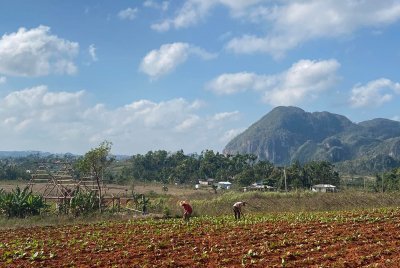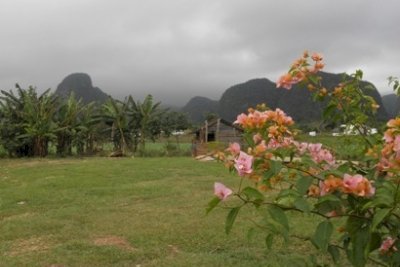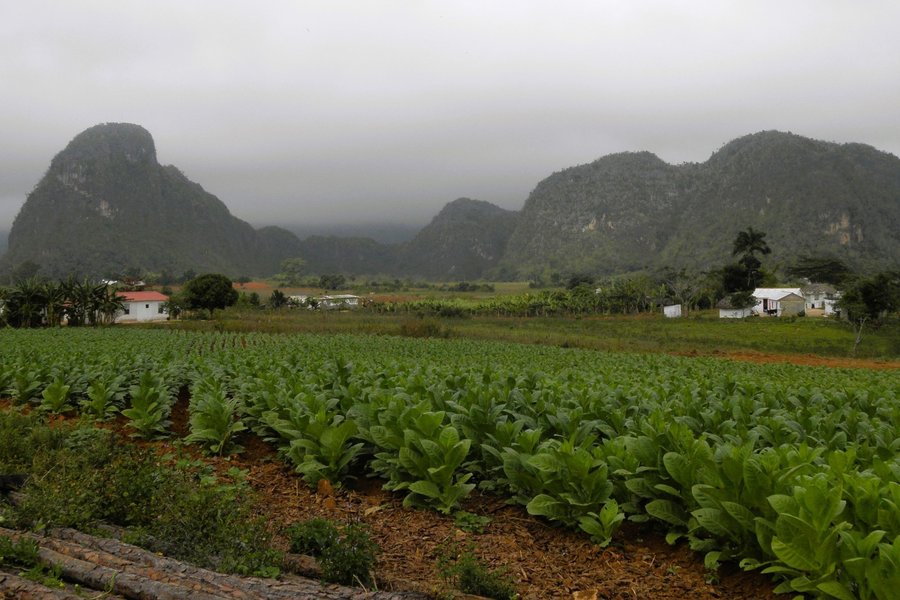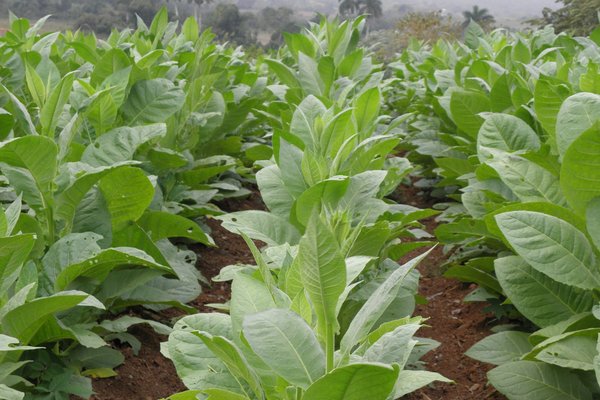Cuba
Viñales Valley
Viñales Valley is a living cultural landscape where traditional agriculture is practiced.
The karst landscape holds fertile soil and a favourable climate, and farming started here in the 17th century. It got a boost in the 1860s because of the rise in tobacco cultivation, which still is the main crop. Tobacco production still is done via traditional, non-mechanical methods.
Community Perspective: it’s a rural area in a visually interesting setting. There are tobacco farms open to tourists where you can watch the process of growing this product.
Site Info
Official Information
- Full Name
- Viñales Valley (ID: 840)
- Country
- Cuba
- Status
-
Inscribed 1999
Site history
History of Viñales Valley
- 1999: Inscribed
- Inscribed
- 1997: Rejected
- Bureau -Doesn't meet Natural criteria, lacks boundaries + protection. (But consider a "Cultural Landscape"?)
- Type
- Cultural
- Criteria
- iv
Links
- UNESCO
- whc.unesco.org
- Related
-
- pnvinales.webcindario.com — Parque Nacional Vinales
All Links
UNESCO.org
- whc.unesco.org — whc.unesco.org/
Related Resources
- pnvinales.webcindario.com — Parque Nacional Vinales
News Article
- Oct. 2, 2022 plenglish.com — Hurricane Ian seriously damaged Cuba’s National Park
- Feb. 7, 2014 cadenagramonte.cu — Viñales Will Offer New Hiking Trails
Community Information
- Community Category
- Human activity: Agriculture
- Cultural Landscape: Continuing
Travel Information
Recent Connections
-
Petroglyphs
In several caves -
Dripstone
In Caverna de Santo Tomás -
Living Fossils
Microcycas calocoma, cork palm, "a livi…
Connections of Viñales Valley
- Geography
-
-
Situated in one of the SIDS
Cuba 1999
-
- Ecology
-
-
Dripstone
In Caverna de Santo Tomás -
Living Fossils
Microcycas calocoma, cork palm, "a living fossil of the Cretaceous phanerogamic flora" (AB ev)
-
- Architecture
-
-
Vernacular architecture
"Most of the buildings scattered over the plain are simple; they are built using local and natural materials, and are used as homes or family farms."
-
- World Heritage Process
-
-
Rejected, and then inscribed
-
Inscribed on a single criterion only
iv. to be an outstanding example of a type of building, architectural or technological ensemble or landscape which illustrates (a) significant stage(s) in human history -
Cultural sites rejected for Natural criteria
-
- Human Activity
-
-
Petroglyphs
In several caves -
Tobacco
-
Coffee
Coffee is among the crops grown -
Maroonage
Slaves from Africa worked on the crop fields here. Also, escaped slaves often found refuge in the caves of the Valley. The Pan de Azucar site contains the ruins of the biggest hacienda, where slaves were taught different trades.
-
- WHS on Other Lists
-
-
Melina Mercouri Prize
1999 Joint winner
-
- Timeline
-
-
Built in the 19th Century
"Les activites economiques et socio-culturelles demarrent aux XVIIe siecle...La culture du tabac fait ensuite son apparition, devenue la principale activite economique " (Nom file) .."The area was colonised at the beginning of the 1800s by tobacco growers from the Canary Islands.. The first settlement in Vinales is documented in 1871, in the form of a ranch .. The town was established in 1878 as a typical community, with church, school, hospital and recreation park" (Wiki) "Visit to EL Palenque de los Cimarrones, a place where a runaway slave's hide-out is recreated and you learn about afro Cuban religion & the history of the slaves in the 19 century" (tourism web site)
-
News
- plenglish.com 10/02/2022
- Hurricane Ian seriously damaged Cu…
- cadenagramonte.cu 02/07/2014
- Viñales Will Offer New Hiking Trai…
Recent Visitors
Visitors of Viñales Valley
- AC
- Adrian Turtschi
- Albert
- Alberto Rodriguez Gutierrez
- Alejandro Lau
- Alexander Barabanov
- Alex Baranda
- Ali Zingstra
- Ammon Watkins
- Anna Wludarska
- Anne
- Antonio J.
- Atila Ege
- Bauchat
- Bram de Bruin
- Bruno_Pires
- Can SARICA
- Chantal den Haan
- Christian Wagner
- Claire Bradshaw
- Csaba Nováczky
- ctravel
- CynthiaSam
- czesioszpachelka
- Daniela Hohmann
- Deffra
- Dimitrios Polychronopoulos
- Els Slots
- Eva Kisgyorgy
- Fan Yibo
- Felicité
- Femke Roos
- Fernweh
- Filip Murlak
- Geert Luiken
- George Gdanski
- GeorgeIng61
- Gernot
- giloudepuertorico
- Hammeel
- Harald T.
- Hughes1920
- Iain Jackson
- Ingrid
- IreneKD
- Ivan Rucek
- Jacob Otten
- Javier
- jballard650
- Jean Lecaillon
- Jens
- João Aender
- Jonas Kremer
- jonathanfr
- Jon Eshuijs
- Joyce van Soest
- KateY
- Kerékgyártó
- Lara Adler
- Loic Pedras
- Lucio
- Ludvan
- Luis Filipe Gaspar
- Lukasz Palczewski
- lynnz317@aol.com
- Maciej Gowin
- Maja
- Malgorzata Kopczynska
- marcel staron
- MarcoB_0
- Marcobrey
- Mariam
- Martina Rúčková
- Mateusz
- MH
- Michael Ayers
- Mikko
- Monica66
- Morodhi
- Neil McPaul
- Nihal Ege
- PabloNorte
- palka25
- Patrik
- petar
- Rahelka
- Randi Thomsen
- Reisedachs
- Remski
- Riccardo Quaranta
- Roel Sterken
- Roger Ourset
- Roman Bruehwiler
- Roman Raab
- Rosemary
- Ryan Gentry
- Sabrina Liebehentschel
- Samy G
- saraleonela
- Slavi
- Stanislaw Warwas
- StaziG
- Svein Elias
- Szabolcs Mosonyi
- Szucs Tamas
- Tamara Ratz
- Thomas Buechler
- Thomas van der Walt
- triath
- Truls Brekke
- Vsacan
- Walter
- Weecheng
- Wojciech Fedoruk
- Xiquinho Silva
- Yongcheng Liu
- Zizmondka
- Zoë Sheng
- Zsuzsanna Forray
Community Reviews
Show full reviews
Visited in January 2023.
The Viñales Valley is located 200 km from Havana, in the province of Pinar del Rio. I booked a tour through the owners of an airbnb apartment in Havana.Europeans came to this valley among the Sierra de los Organos mountain range only at the beginning of the 19th century, three hundred years after the beginning of the colonization of the island. It turned out that the local climate is ideal for agriculture, especially for the cultivation of tobacco.Since then, the technology of this process has not changed much. Large-scale production with its mechanization is considered to have a negative impact on the quality of the product, so the villagers here still do everything by handwork. Each tour takes you to a tobacco farm, where you can watch how tobacco is processed and cigars are made. In principle, the service is unobtrusive, and it is really interesting to get acquainted with the process of making cigars. The continuity of tobacco traditions and the folk architecture of villages and individual farms have been considered World Heritage. The second factor in recognizing the UNESCO status is the karst formations, primarily mogote, isolated limestone mountains resembling domes. As usual in karst formations there are many caves, one of which, the Cueva del Indio, can be entered for a symbolic fee. The cave is not the most impressive of those I have been to, but part of the route has to be overcome by boat. It is also nice to …
Keep reading 0 comments
In hindsight, this was the area of Cuba that I liked best. Especially its natural surroundings. Surely I had seen a karst landscape or two before, and the size of this is no match for China's Yangshuo/Guilin, but "diving" into this valley by road is a spectacular sight. Its little hills, tobacco plants and colourful flowers do add an extra touch to the standard Cuban landscape of banana plants and royal palms.
Another thing that sets Vinales apart is that it is such a small town, just pottering around a bit far from the rest of the action of Cuba. It's a totally relaxed place. The town's inhabitants seem to have completely surrendered themselves to tourism. About 80% of the houses are in use as Casas Particulares. The rest sell drinks, food, or souvenirs. Large touring cars travel on and off through the town's main street, delivering more tourists (including day-trippers from Havana or even the beach resorts).
To see the valley's main sights, I joined a bike tour. Although the valley is only 12km long, I found it quite a tough ride. Cuban-made mountain bikes aren't the most comfortable in the world. And those nasty mogotes! Annoying little hills always involve a steep climb. On the way back we also had the wind against us. So I am not ashamed to say that I walked a fair bit of the last 5 km.
Part of the tour was the obligatory visit to a tobacco farm. I …
Keep reading 0 comments
Accorfding to UNESCO, Vinales is on the list because "traditional methods of agriculture (notably tobacco growing) have survived unchanged there for several centuries. The region also preserves a rich vernacular tradition in its architecture, its crafts, and its music." Unfortunately these are the kinds of qualities that are not always easily discernible to the passing tourist as I was in 2001 when I visited. It is set in a Karst landscape that was visually intersting - but that was before I visited Halong bay and the Gulin/Yangshuo area of China. My friends and I had a pleasant stop there at a local homestay, where we had the best food we ate in Cuba (not much competition though I'm afraid). If you have a particular interest in
Cuban culture, tobacco growing, or are passing that way anyway, Vinales town is worth a stopover, but I wouldn't plan a holiday around it.
Keep reading 0 comments
